|
|
|
 |

 |
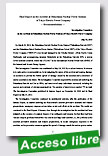 |
Final Report on the Accident at Fukushima Nuclear Power Stations of Tokyo Electric Power Company - Recommendations
Investigation Committee on the Accident at Fukushima Nuclear Power Stations of Tokyo Electric Power Company, 23 July 2012, 14 p.
This Investigation Committee was established on May 24, 2011 by a cabinet decision. Its mission is to make policy recommendations, by investigating the causes of the accident and ensuing damage, on measures to prevent the further spread of damage caused by the accident and a recurrence of
|
similar accidents in the future. The Investigation Committee inspected the accident site including the Fukushima Dai-ichi and Dai-ni NPSs, and interviewed many individuals concerned, including the mayors and residents of relevant municipalities. The number of interviewees reached 772 in total. The Investigation Committee published its Interim Report on December 26, 2011 and its Final Report on July 23, 2012.
Extraído de:
http://icanps.go.jp/eng/SaishyuRecommendation.pdf
|
 |
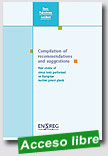 |
Compilation of recommendations and suggestions - Peer review of stress tests performed on European nuclear power plants
European Nuclear Safety Regulators Group (ENSREG), 2012, 9 p.
As part of the ENSREG Action Plan regarding the follow-up of the peer review of the stress tests performed on European nuclear power plants ENSREG decided to prepare by September 2012, a consistent compilation of stress test peer review recommendations and suggestions to assist the preparation or review of national action plans by national regulators. The compilation is provided in the attached PDF file.
|
Extraído de: http://www.oecd-nea.org/
|
 |
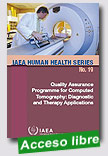 |
Quality Assurance Programme for Computed Tomography: Diagnostic and Therapy Applications
IAEA Human Health Series, 2012, 171 p.
This publication presents a harmonized approach to quality assurance in the field of computed tomography applied to both diagnostics and therapy. It gives a careful analysis of the principles and specific instructions that can be used for a quality assurance programme for optimal performance and reduced patient dose in diagnostic radiology. In some cases, |
radiotherapy programmes are making a transition from 2-D to 3-D radiotherapy, a complex process which critically depends on accurate treatment planning. In this respect, the authors also provide detailed information about the elements needed for quality assurance testing, including those relating to accurate patient characterization as needed for radiotherapy treatment planning.
Extraído de: http://www-pub.iaea.org/books/IAEABooks/8751/Quality-Assurance-Programme-for-Computed-Tomography-Diagnostic-and-Therapy-Applications
|
 |
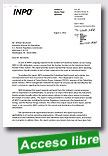 |
This report is an addendum to INPO 11-005, Special Report on the Nuclear Accident at the Fukushima Daiichi Nuclear Power Station, and information from the Special Report served as the foundation for the review team’s activities. The concurrent event at the Fukushima Daini Nuclear Power Station was also reviewed as a source of operating lessons during the preparation of this addendum.
|
Extraído de:
http://pbadupws.nrc.gov/docs/ML1221/ML12219A131.pdf
|
 |
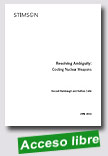 |
Resolving Ambiguity: Costing Nuclear Weapons
Henry L. Stimson Center, June 05, 2012, 70 p.
As the defense budget comes under increasing pressure, many have suggested nuclear weapons as an area for savings. But estimates of what the United States spends on nuclear weapons widely vary.
This report provides an estimate of US spending on nuclear weapons that resolves most of the ambiguity created by that variance. It makes two key contributions to the debate about nuclear weapons spending and nuclear weapons policy. First, it clarifies there are few disagreements about the costs of
|
particular components of the nuclear enterprise-which are usually based on official accounts. Instead, most of the ambiguity stems from disagreements about what should be included as nuclear costs under the broad umbrella of costs associated with or related to nuclear weapons. This report reviews official estimates and independent studies, and then arrays these in a like manner to demonstrate most disagreement is definitional.
Second, this report takes a new approach to estimate the costs of the most uncertain part of the nuclear enterprise. It provides a new estimate where disagreement is real and not just definitional. Although many costs might be reasonably included as part of the broader nuclear enterprise, the costs associated with strategic nuclear offensive forces are most contested and yet also most relevant to on-going policy debates. Although the Departments of Defense and Energy each have an account dedicated to these costs, there are costs that support strategic nuclear offensive forces outside of these accounts as well. For the Department of Energy, these costs introduce relatively small swings in estimates; conversely, the size of the Department of Defense budget allows for very large swings in estimates. This report uses an inductive, bottom-up method to estimate the costs within the Defense Department more exactly than previous studies, which have relied on deductive, top-down methods.
Using this methodology, this report estimates that the Department of Defense spends $23 billion in support of strategic nuclear offensive forces. Of these costs, $12 billion are found in the account dedicated to strategic forces, while $11 billion support strategic nuclear offensive forces, but lay outside of the account dedicated to strategic nuclear offensive forces. Despite the greater granularity of this methodology, some uncertainty remains for two primary reasons: the difficulty in assigning costs of aerial refueling tankers that support strategic nuclear offensive forces, and the theoretical difficulty in clearly delineating what is strategic nuclear offensive forces.
This report estimates an annual total of $31 billion is spent on nuclear weapons when costs dedicated to strategic nuclear offensive forces found in the National Nuclear Security Administration of the Department of Energy are included. Although this report focuses on a single-year estimate, it also extrapolates these costs over a 10-year period of time. It then adds in the additional modernization costs resulting from development programs to replace ballistic missile submarines and strategic bombers. In total, this report estimates that the United States will spend between $352 and $392 billion on strategic nuclear offensive forces over the next 10 years. As with the single-year estimate, these sums do not include modernization programs like the next-generation aerial refueling tankers, which could significantly alter the 10-year estimate. This estimate does not represent all of US government spending on nuclear weapons-the broader nuclear enterprise-but only an estimate of the spending on a single subset: strategic nuclear offensive forces.
At the very least, this study should clarify that official estimates relying on a narrow definition of the nuclear enterprise, or even of strategic nuclear offensive forces, understate the actual costs the United States spends on nuclear weapons without settling once and for all what is the single right cost of the nuclear enterprise.
Extraído de: http://www.stimson.org/spotlight/resolving-ambiguity-costing-nuclear-weapons/ |
 |
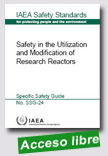 |
Safety in the Utilization and Modification of Research Reactors
IAEA Safety Standards Series, 2012, 68 p.
This Safety Guide is a revision of Safety Series No. 35-G2 on safety in the utilization and modification of research reactors. It provides recommendations on meeting the requirements for the categorization, safety assessment and approval of research reactor experiments and modification projects. Specific safety considerations in different phases of utilization and modification projects are covered, including the pre-implementation, implementation and post-implementation phases. Guidance is
|
also provided on the operational safety of experiments, including in the handling, dismantling, post-irradiation examination and disposal of experimental devices. Examples of the application of the safety categorization process for experiments and modification projects and of the content of the safety analysis report for an experiment are also provided. Contents: 1. Introduction; 2. Management system for the utilization and modification of a research reactor; 3. Categorization, safety assessment and approval of an experiment or modification; 4. Safety considerations for the design of an experiment or modification; 5. Pre-implementation phase of a modification or utilization project; 6. Implementation phase of a modification or utilization project; 7. Post-implementation phase of a utilization or modification project; 8. Operational safety of experiments at a research reactor; 9. Safety considerations in the handling, dismantling, post-irradiation examination and disposal of experimental devices; 10. Safety aspects of out-of-reactor-core installations; Annex I: Example of a checklist for the categorization of an experiment or modification at a research reactor; Annex II: Example of the content of the safety analysis report for an experiment at a research reactor; Annex III: Examples of reasons for a modification at a research reactor.
Extraído de:
http://www-pub.iaea.org/books/IAEABooks/8854/Safety-in-the-Utilization-and-Modification-of-Research-Reactors
|
 |
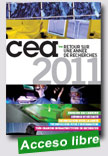
|
Retour sur une Année de Recherches
Commissariat à l’Énergie Atomique et aux Énergies Alternatives, 2012, 32 p.
L’année 2011 fut, pour le CEA, marquée par le grave accident de Fukushima. Cet événement a ouvert un débat sur le meilleur bouquet énergétique souhaitable à court et moyen terme, tant au niveau national qu’international. Le CEA y a exprimé sa vision d’une complémentarité profonde des énergies renouvelables et nucléaire. Une complémentarité jalonnée par des avancées significatives dans les recherches sur les biocarburants, les
|
batteries pour véhicules électriques ou encore les cellules photovoltaïques, mais également par les étapes clés franchies dans la conception d’un prototype de réacteur à neutrons rapides, ou le calcul intensif pour les études de sûreté et de fonctionnement des coeurs de réacteur. Plusieurs projets du CEA bénéficient de financements pluriannuels au titre des Investissements d’avenir, atout majeur pour les mener à bien. Des énergies pour l’avenir au CEA, ce sont surtout ses personnels, leur force vive et leur mobilisation, qui continueront en 2012 à assurer de manière exemplaire les missions confiées par l’État et à répondre ainsi aux grands enjeux sociétaux que sont également la défense et la sécurité, les technologies pour la santé et l’information, la conception et l’exploitation de grandes infrastructures de recherche.
Extraído de:
http://www.cea.fr/content/download/80029/1535821/file/panorama2011.pdf
|
 |
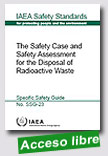 |
The Safety Case and Safety Assessment for the Disposal of Radioactive Waste
IAEA Safety Standards Series, 2012, 120 p.
This Safety Guide provides guidance and recommendations on meeting the safety requirements in respect of the safety case and supporting safety assessment for the disposal of radioactive waste. The safety case and supporting safety assessment provide the basis for demonstration of safety and for licensing of radioactive waste disposal facilities and assist and guide decisions on siting, design and operations. The |
safety case is also the main basis on which dialogue with interested parties is conducted and on which confidence in the safety of the disposal facility is developed. This Safety Guide is relevant for operating organizations preparing the safety case as well as for the regulatory body responsible for developing the regulations and regulatory guidance that determine the basis and scope of the safety case. Contents: 1. Introduction; 2. Demonstrating the safety of radioactive waste disposal; 3. Safety principles and safety requirements; 4. The safety case for disposal of radioactive waste; 5. Radiological impact assessment for the period after closure; 6. Specific issues; 7. Documentation and use of the safety case; 8. Regulatory review process.
Extraído de: http://www-pub.iaea.org/books/IAEABooks/8790/The-Safety-Case-and-Safety-Assessment-for-the-Disposal-of-Radioactive-Waste
|
 |
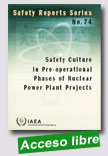 |
Safety Culture in Pre-operational Phases of Nuclear Power Plant Projects
IAEA Safety Reports Series, 2012, 69 p.
An abundance of information exists on safety culture related to the operational phases of nuclear power plants; however, pre-operational phases present unique challenges. This publication focuses on safety culture during pre-operational phases that span the interval from before a decision to launch a nuclear power programme to first fuel load. It provides safety culture insights and focuses on eight generic issues: safety culture
|
understanding; multicultural aspects; leadership; competencies and resource competition; management systems; learning and feedback; cultural assessments; and communication. Each issue is discussed in terms of: specific challenges; desired state; approaches and methods; and examples and resources. This publication will be of interest to newcomers and experienced individuals faced with the opportunities and challenges inherent in safety culture programmes aimed at pre-operational activities.
Extraído de: http://www-pub.iaea.org/books/IAEABooks/8792/Safety-Culture-in-Pre-operational-Phases-of-Nuclear-Power-Plant-Projects
|
| |
|
|
|
| |
|
|
|
|
|
|
